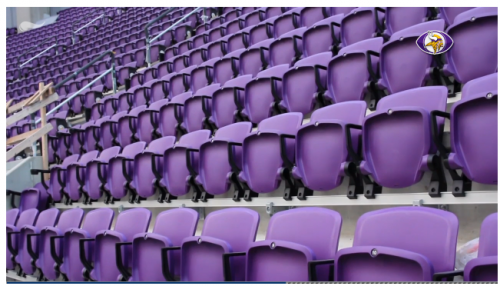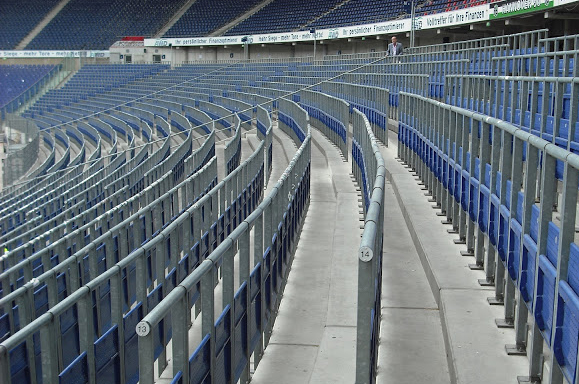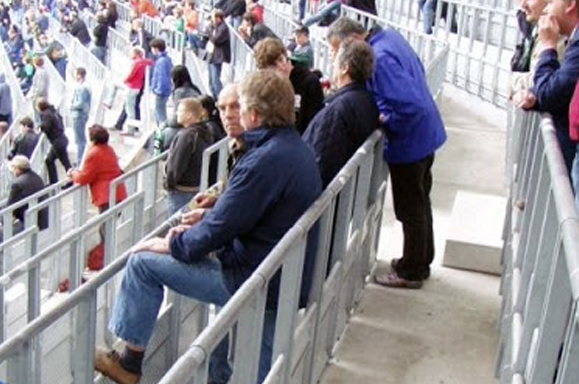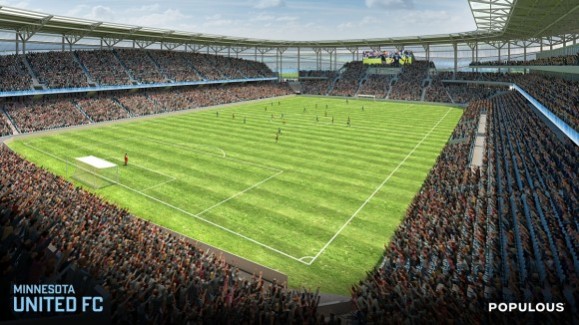Lead designer for Populous, Bruce Miller, speaks exclusively to FiftyFive.One about the ‘safe standing’ supporters section planned for the Minnesota United stadium.
When Minnesota United FC publicly unveiled its stadium design back in February, primary owner Dr. Bill McGuire made a point of highlighting the club’s plans to incorporate a large, single tier supporters section behind the venue’s south goal.
To the delight of the team’s two largest supporters groups, the Dark Clouds and True North Elite, McGuire went on to note that this area would feature what has come to be known as safe standing. Since the February announcement, however, specifics on Minnesota’s stadium have been sparse, leaving many fans anxiously awaiting additional news.
Late last week, when it became clear that progress was finally being made on the team’s legislative asks at the state capitol, the stadium’s lead designer, Bruce Miller of Populous, offered FiftyFive.One exclusive insight on how Minnesota United is approaching the supporter experience at its new home in St. Paul.
Details Emerge
Miller confirmed that safe standing is still very much a part of Minnesota’s plans, which have now reached the end of the Schematic Design phase. With this news, Minnesota joins Orlando City – whose stadium was also designed by Miller’s team at Populous – as pioneers of the safe standing movement in the United States. San Jose’s Avaya Stadium, it should be noted, also incorporates a small standing terrace, but it is a fraction of the scale of what is being built in Orlando and proposed in Minnesota.
It is believed that Minnesota’s supporters’ section will be the steepest stand in Major League Soccer and will give fans a commanding view of the field and a looming presence over opposing goalkeepers.
Capacity of Minnesota’s standing section has been a subject of speculation since the initial announcement. While the number has fluctuated some as the design has been refined, Miller confirmed that Minnesota’s standing section will have a capacity of 3,000. Orlando’s final standing capacity is slightly larger at 4,000, but Miller noted that Minnesota fans will be pleased with the fact that the rake or angle of Minnesota’s stand will be steeper. It is believed that Minnesota’s supporters’ section will be the steepest stand in Major League Soccer and will give fans a commanding view of the field and a looming presence over opposing goalkeepers.
When safe standing was first announced, many assumed that it would take the form of the so-called rail seats commonly found in Germany. The rail seat configuration features a galvanized steel guardrail with a built-in rudimentary flip up seat that can be locked in the upright position when standing is desired and can be converted to seating when required for international competition. Manufacturers like German company Stechert and English outfit Ferco have carved out a niche market making and distributing rail seats – or vario-seats as they’re often called in Germany – to clubs and stadium operators across Europe. While these products are widely accepted as the preferred approach to safe standing, they are not yet readily available in the US, and as architect Bruce Miller pointed out, they come with a significant upfront cost equal to “about the same price as padded armchairs.”
The system to be implemented at Minnesota United’s stadium, as described by Miller, is as simple as attaching a continuous guardrail in front of each row of steeply raked concrete risers.
Populous’ solution to these challenges is simple; lose the seat but keep the rail. Rather than attempting to import expensive all-in-one units from Europe, the design team is working to create the same effect with a slightly different kit of parts that is easier to source in the United States. The system to be implemented at Minnesota United’s stadium, as described by Miller, is as simple as attaching a continuous guardrail in front of each row of steeply raked concrete risers. The integral seat typically seen in Europe will be omitted altogether leaving fans with a large embankment intentionally designed as a standing-specific environment. The architect was also quick to point out one perk that Minnesota’s fans will surely appreciate; each and every one of the new stadium’s 3,000 standing spaces will have its own cup holder.
If international competition requires the installation of seats, Miller suggests that the club could install temporary seats that are pre-mounted on a track for rapid installation using a product similar to the seats recently installed at US Bank Stadium. Miller, however, is optimistic that these seats won’t need to be purchased, adding that he is hopeful that officials at CONCACAF and FIFA can eventually be convinced that Populous’ take on modern, safe standing enhances fan safety to a level that far exceeds the status quo of standing in seated areas.

The Case for Standing
While Miller, a leading voice in global stadium design, is now a believer in safe standing, it’s not a position he arrived at lightly. With tragic events like the 1989 Hillsborough disaster still making headlines, Miller and his team approached the idea with great caution. When asked how he first reacted when a client (Orlando City’s ownership group) first asked him to incorporate a large standing area into a design, Miller replied:
I must’ve watched ESPN’s 30 for 30 documentary on Hillsborough 20 or 30 times. I wanted to understand how it happened. I wanted to understand why it happened. I needed to do this before I could feel comfortable making the case that it [standing in large numbers] can be safe.
Miller and the team at Populous then did extensive research on the subject, focusing particular attention on the German Bundesliga, a league with modern venues where roughly one out of every four tickets sold is for a Stehplatz or standing space. What the team of architects found was a wide range of standing configurations, all with different variables that affect fan safety.
Many German stadiums, for example, feature the previously mentioned rail seats, but configure them in a way that allows standing capacity to be greater than seated capacity by placing two risers between every rail. This practice of intentionally double loading the space between each rail was not something Populous felt comfortable with. As a result, the standing configuration to be used in Minnesota and Orlando will be a direct 1:1 ratio with each fan having a numbered standing space on a single loaded riser with one rail in front and one rail behind. In the event that seats are ultimately installed for international competition, the capacity of the stands will remain the same.

The one fan per one marked space approach ensures that planned, safe capacity is not exceeded and does so in manner that is far easier for in-stadium ushers and other officials to track. Reacting to the question of whether or not he has received any push-back from American building officials or fire marshals unfamiliar with the notion of safe standing, Miller stated without hesitation “No, it’s an easy, safe proposition for me to make.” Safe standing in a 1:1 configuration with guardrails in front of each fan, Miller argues, is simply a more honest, responsible strategy for stadium designers to acknowledge the way in which many soccer supporters already use their stadiums. The possibility of what Miller called a “domino effect” of fans standing on benches, seats, and seat-backs – which often leads to injuries and unintentional damage – is completely removed with safe standing. Trip hazards in the form of low seat-backs and the danger of forward crowd surges are no longer a concern when fans are given a level surface to stand on and a protective rail in front of and behind them.

Driven by Owners’ Passion
One of the more interesting items Miller discussed is the degree to which safe standing in Major League Soccer has been championed by individual ownership groups. Orlando City’s owner Flavio Augusto da Silva, it seems, can be credited with leading the charge, and Minnesota United’s ownership group led by Dr. Bill McGuire soon joined the ranks. Both groups have repeatedly stressed the importance of fostering a supporter-driven atmosphere in their new stadiums and both felt strongly that a large safe standing section, coupled with an atmosphere enhancing roof canopy, is an effective way to achieve it. By contrast, there are no plans at present to include safe standing in DC United’s new stadium at Buzzard Point, also being designed by the team at Populous.
In a November 2015 article by Sports Illustrated’s Tim Newcomb, Miller noted the importance of spectacle and procession in the soccer fan experience. He reiterated that point last week and described the vigorous discussions that have taken place internally about where to locate Minnesota’s supporters section. On one hand, there is argument to be made for locating the Dark Clouds and True North Elite at the geographic north of the stadium. The obvious connection to the club’s rallying cry – The North Is Rising – was difficult to ignore. When looking at the location in the context of the overall site, however, the stadium’s southern end began to make more sense.
Miller, who said he understands the appeal of both locations, is supportive of the entrance spectacle made possible by locating supporters in the south end. He cited conversations with team officials in which they envisioned groups of new fans walking into the stadium from the plaza for the first time and being presented with an unobstructed view of 3,000 black and blue clad, flag waving fans across the length of the emerald green field. It may still be a few years from reality, but that’s a vision we can all support.

Leave a Reply